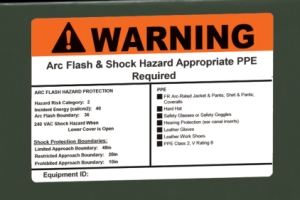 National Fire Protection Association, National Safety Council, and Bureau of Labor Statistics data indicate that 10 arc flash accidents happen every day in the U.S. More than 3,600 disabling electrical contact injuries happen every year.
National Fire Protection Association, National Safety Council, and Bureau of Labor Statistics data indicate that 10 arc flash accidents happen every day in the U.S. More than 3,600 disabling electrical contact injuries happen every year.
Last year in Oregon two workers were seriously burned in arc flash incidents:
July 2012: A worker was troubleshooting an electrical system for a water pump at a client's site. As he tested the in-feed side of the power in the disconnect box, there was an arc flash that burned his left hand and arm.
September 2012: A worker was working in a panel box changing a contactor when the contactor failed, causing an arc flash that burned his left arm, face, and neck.
The accident described below, which happened in 2011 when an Oregon worker was retrieving fish tape from a conduit line, shows what can happen when the requirements of a Level II hot work permit are ignored.
Worker seriously burned in arc flash explosion
Workers were installing 480-volt nominal service at a food processing plant for future use. At the time, the plant was using existing service at the same branch circuits. The system was live at the panel where the workers were attempting to take a measurement for an additional service wire.
The victim was waiting at the end of eight separate conduit holes to retrieve fish tape that workers on the second floor were running through conduit they had installed for the new service.
Although he was not sure from which one of the eight conduits the fish tape would emerge, he lay on the ground expecting it to be a lower one. As he was watching, the end of the tape sprung out of a higher conduit; however, because the bus bar was activated and carrying an electrical load of approximately 480 volts nominal AC and 3,000 amps, as soon as it touched the back of the bus bar, it created an explosion and fireball.
He received burns from the fireball on his face and the back of his hands. The arc flash blew out two of the branch circuit boxes and burned the rest of the services.
One of the workers watching as the victim was attempting to receive the fish tape immediately ran down two flights of stairs to tend to him after the accident.
Another employee, who was pushing the fish tape through from the second floor, experienced a near miss when a flame came out of the conduit just two feet from his shoulder. He felt the heat of the 1,500-degree flame but did not receive an injury.
After emergency responders arrived, the victim was transported to a nearby hospital where he was treated and transferred to the Oregon Burn Unit in Portland for second- and third-degree burns to his face and hands.
The work required a Level II hot work permit, which included a qualified buddy (journeyman electrician), hard hats, safety glasses, full-face shield (flash rated, nonconductive), rubber gloves (properly rated and tested at 1,000 volts per minute), double-insulated hand tools, flame retardant outer garments, a copy of the "hot work process," and a rescue system.
But the victim did not have a Level II hot work permit – only one pair of safety glasses.
Source: Oregon OSHA www.orosha.org



